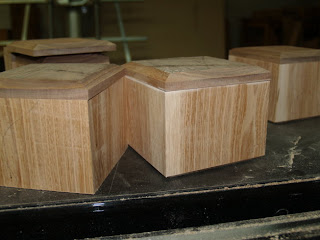 |
| A sample for a corporate gifts order, walnut and white oak. |
Taking a hand-centric view, that regards teaching as an art, invites the use of artists's tools into the discussion of where we are going in American education. We all know the difference between 2 dimension as in painting and drawing and 3-d as in useful objects and sculpture. 4-D is about designing a thing or a relationship that is fluid over time, like a school culture or a curriculum or classroom activity. It might be helpful to take the principles and elements of design and go point-by-point how they could be utilized in a hand-centric redesign of American education. I mentioned
effective surprise as being one goal of good 3-d or 4-d design. I don't know how much time I have to make a daily commitment to this, so it will be brief. It is ironic that artists would have a systematized view of good design, while educators would not. Can it be that art is closer to science these days than education?
 |
| Boxes can serve as concrete examples to illustrate design. |
Today I will concentrate on unity, one design principle (goal) from the list: unity, harmony, contrast, proportion, rhythm, balance and effective surprise, and leave the elements of design (tools), for future posts except as they can be conveniently woven in.
It is easiest to describe the principles and elements of design if using concrete objects as examples to provide a sense of the abstract, so I offer the photo of boxes above as a concrete starting point in the discussion of unity. The box is shown with routing on the right and on the left without. The routing at the bottom of the box provides a shadow line around the base, suggesting that it is separate from that upon which it rests. Some care in matching woods (color and line) at the corners of the box give a sense of unity to the box itself. The lid is obviously separate from the body of the box, with a clear line where it will lift apart, but the edges of the lid align with the edges of the body of the box. These design elements create a sense of unity in the box, and define that unity as being separate and distinct within itself.
In education, the principle of unity is important, as each child must be encouraged to feel a significant part of things in order for effective learning to take place. The child must feel a part of the school, the class, and have a sense of shared purpose within. For effective learning to take place, the child must be woven into the group, into relation with the school and teacher and peers. This is not always an easy thing, but on the child's sense of unity, all else rests. Just as in a box, unity is established through the use of lines, color, shape, texture, groupings of parts, within a classroom, arrangements can be made to include and make all students feel part of a thing larger than themselves. Creating a sense of unity is dependent on strong values and character education, concerning respect for ideas, and individuals within the group. One of the challenges in most schools is classroom size. In large classes, teachers often have little time to draw in those at the edges of participation or to create a sense of unity. Many politicians these days as they cut school budgets and attempt to force school reform on local communities will tell you that class size doesn't matter. It does.
After I have gone through the goals, and explained them, I will offer blog posts explaining the tools designers whether teachers (or artists) can use to attain them. And or course, I am going out on a limb here. I had never heard of the principles and elements of design being applied to teaching before. Are you with me?
American craft magazine this month offers an article asking, "Is the Future of Craft in Design?" with the question really being, should craftsmen hire others to do their work and implement their vision and thereby remove themselves from the tangible creative process? I suggest that understanding the principles and elements of design through an exploration of concrete objects is useful regardless of which path you would choose to take. And as for myself, I choose the path with the maximum engagement of hands. My own.
Today I've been getting ready for Eurekapalooza on Saturday and making prototype boxes for a possible corporate gifts order. The prototype box is shown at top.
Make, fix and create...





































